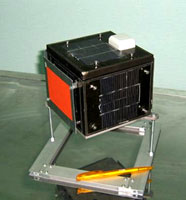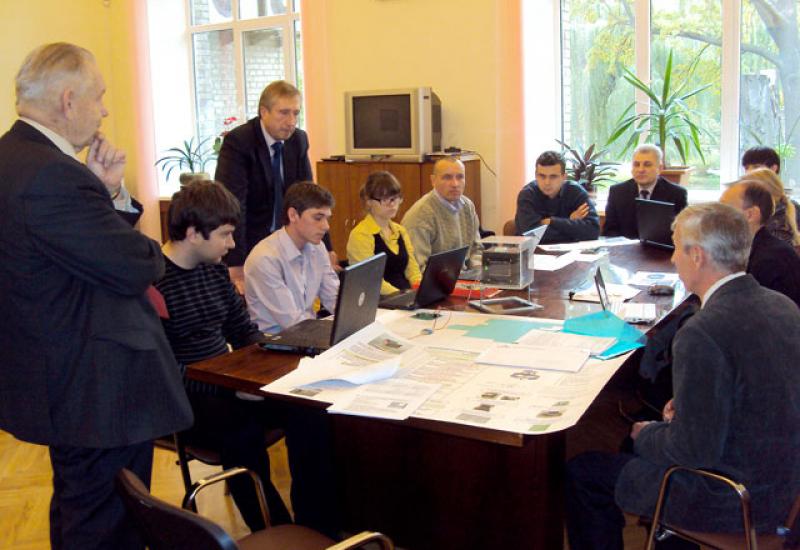Today most of large higher educational establishments in the world have university small-size space craft (SC) – nanosatellite creation programs. Creation of nanosatellites is a promising area of youth involvement with space subject. Such SCs are being developed as a part of format CubeSat – the SC conception suggested by the professor of Stanford University Robert Twigs. They are cheap and can be produced in a short space of time. Considering the modern development of electronics, microprocessor units and other technologies, small groups of students funded from the universities can produce small SCs. Participating in constitution and electronic platform drafting and producing an engineer model students promote their professional qualification.
At NTUU “KPI” nanosatellite development has been underway already for year and a half. The scientific group of students and teachers from Heat-and-Power Engineering Department, Faculty of Electric power engineering and Automatics, Radio Engineering Faculty and Faculty of Electronics works at its development. The group fills in all the elements of electronic platform and nanosatellite firmware. The honeycomb panel construction and nanosatellite technologies laboratory chief, Candidate of Engineering B.M. Rassamakin.
On October 28th 2011 the meeting of the members of the group and the NTUU “KPI” principal, academician NAS of Ukraine M.Z. Zgurovskiy and vice-principal for research, corresponding member of NAS of Ukraine M.Y. Il’chenko. During the meeting the activity progress was discussed.
The KPI nanosatellite has little more than 1 kg in weight and a size of 14x14x13 cm. It consists of four modules: power generation module, radio communication circuit module, command module and payload module.
Power generation module development, simulation and producing are conducted by the post-graduate student from the Faculty of Electronics Yevhen Kovalenko (consultants are assistant professor O.V. Budenniy, Professor V.Y. Zhuykov). The module provides the ultimate output selection from solar batteries, batteries charging, and voltage supervision on every battery element, battery elements charge equilibration, element redundancy and stabilized voltage output values creation.
Radio communication circuit module is in charge of the earth connection and has two radio channels at 435 MHz and at 2,4 GHz. Via the channel at 435 MHz the commands are transmitted to the satellite and telemetric information is transmitted back. The fast-acting channel at 2,4 GHz serves to information transmission from the payload module. Radio communication circuit module is being developed by the students of Radio Engineering Faculty Oleh Taranukha and Nazariy Bendasiuk (the consultant is senior lecturer M.A. Pershin).
Command module consists of four subsystems: orientation and stabilization, navigation (GPS/GLONASS), telemetering, data processing and nanosatellite mode control.
 Nanosatellite subsystems software is being developed by the students of the Heat-and-Power Engineering Department, among them worth notice are Ihor Ostrovskiy, Mykola Anikeyenko and Julia Savinkova (their consultants are the lecturer D.S. Smakovskiy and leading engineer A.S. Menzhega). It is worth noting that the whole software development at our university provides the independence and discretion on further stages of development.
Nanosatellite subsystems software is being developed by the students of the Heat-and-Power Engineering Department, among them worth notice are Ihor Ostrovskiy, Mykola Anikeyenko and Julia Savinkova (their consultants are the lecturer D.S. Smakovskiy and leading engineer A.S. Menzhega). It is worth noting that the whole software development at our university provides the independence and discretion on further stages of development.
Power generation module, radio communication circuit module and command module are the core part on which basis the series of nanosatellites can be designed.
The key task of the nanosatellite is completed by the payload module. For each satellite launching the unique payload module is created. On such module photocameras, radiation sensors, degradation sensors etc. can be installed; different investigations and apparatus trial run in outer space can be conducted.
NTUU “KPI” nanosatellite hardware components are produced of fittings available on the market and on their base university’s own modules are made.
One of the key requirements while creating SC is the existence of special experimental facilities at university. While implementation of the university nanosatellite program not only the small-size SC, but also the testing apparatus is developed. The non-flying thermal vacuum tests of SC by simulating the impact of physical factors of space are conducted using the facilities of NTUU “KPI”. The non-flying testing research association of the Heat-and-Power Engineering Department and Faculty of Electric power engineering and Automatics (the chief of the scientific laboratory is the assistant professor V.I. Khominich, the students of the Heat-and-Power Engineering Department Katerina Yeliseyeva, Taras Tsiuk) is created and modernized.
Till the end of the year the staff is going to finish the development and producing of all the subsystems of the nanosatellite research model. Its orbital launching is scheduled for 2013. The height of the orbit is 680-700 km.
- During the meeting
- Nanosatellite KPI

